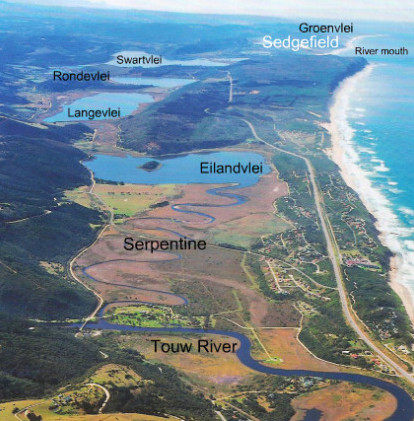Published: 29-Oct-2019
Enjoy a Fishing Retreat in Wilderness
With a coastline of almost 3000 kilometres long, and numerous dams, lakes, rivers and streams, South Africa has plenty to offer the fishing enthusiast. Treedom Villas is located in the heart of the Garden Route, and offers not only easy access to excellent fishing locations, but a beautiful escape surrounded by gorgeous scenery - a dream location for a fishing holiday. Here's more information about our Treehouse Luxury Villa in Wilderness.
 Where to fish in Wilderness
Where to fish in Wilderness
The Garden Route offers many opportunities for recreational fishing. There’s surf and rock fishing to be enjoyed in many pristine and beautiful places like Swartvlei and Cola Beaches, Gerickes Point, Buffalo Bay, Goukamma Nature Reserve (no bait collecting though), Knysna Lagoon, Wilderness Beach, Victoria Bay pier, and Kleinkrantz.
In from the shoreline at Sedgefield, there’s Swartvlei Lake where you can fish from the disused railway line or from a boat (launch at Pine Lake Marina). Depending on the tide you can also fish in the estuary, launching your boat from the Island at Fish Eagle Green or from the boat launch on Kingfisher Drive.
There's also Eilandvlei close to Wilderness. Eilandvlei is part of the Wilderness Lakes which are made up of three coastal lakes - Island Lake, Langvlei and Rondevlei. Island Lake (previously known as Eilandvlei) is the deepest in the system with a maximum depth of 6.5 m and a surface area of 1.5 km2. Treedom is on the border of Island Lake.
Fishing at Groenvlei, Wilderness
Groenvlei, also called Lake Pleasant, is situated just outside Sedgefield and close to Knysna, only a 20 minute drive from Wilderness. Groenvlei is one of the few natural lakes to contain bass in South Africa and many anglers report that they have enjoyed the best bass fishing in South Africa at Groenvlei. The large Mouth Bass or Black Bass fish is much sought after by sport fishermen as it is hardy and hard fighting and is ideal for “catch and release” purposes. Other fish in the lake include Tilapia, Bluegill and Carp.
The Groenvlei Lake is approximately 4 km long and 1 km wide. It is also not deep, with a maximum depth of around 3 metres and very few “holes” up to 5 metres deep. Only electric motors are allowed on the lake; outboard motors have to be lifted clear of the water at all times. Groenvlei has no rocks, points or drop-offs. The entire lake is surrounded by a dense mat of grass and a wide bed of reeds. There are also random patches of grass in other parts of the lake including the centre. Bass are to be found in most these grass beds.
The scenery, bird life and tranquillity at Lake Pleasant make it a worthwhile excursion. Binoculars and cameras are essential as you can spot wildlife on the shores or in the water.
Permits for fishing in Wilderness
Anglers are required to have recreational fishing licences to fish public waters in South Africa(sea, estuary, river, public dam) but not private waters (e.g. farm dams). For inland waters a CapeNature angling permit is required, whereas a marine angling licence is required to fish estuaries and the sea. Fishing permits can be obtained from SANParks offices in Wilderness at Ebb & Flow Rest Camp.
What fish can you catch in Wilderness?
The Department of Agriculture, Forestry and Fishing publishes an annual recreational fishing pamphlet to guide recreational fishermen regarding the number and species of fish they may catch and where they may catch them. Here is the latest Recreational Fishing Brochure (2017-2018).
Conservation tips for fishing in Wilderness
- Limit your catch, don’t catch your limit – leave something for tomorrow and for future generations.
- Don’t target big fish (breeding stock) in their prime for the sake of landing a trophy specimen like a 30-75 kg Dusky Kob just to earn some serious bragging rights. They take 5 years to reach maturity i.e. breeding age and can live to 42 years. Trophy specimens are generally not good for eating and if caught with inadequate tackle (e.g. 4 kg line catching a 20 kg fish) it would probably be half dead when landed with little chance of survival.
- Behave responsibly and take your plastic bottles, polystyrene food containers, plastic bags and other refuse with you. Leave only footprints.
- Be an example to others and don’t endanger other shore life (and beach goers) Gather up broken lines, hooks, plastic bait containers, etc.
- Return indigenous fishes (e.g. Clanwilliam yellowfish, sawfin and whitefish) to the water. These fishes are threatened with extinction as they have been eliminated from much of their former ranges by alien fishes such as the two black bass species, carp and sharptooth catfish.
- You need a permit to transport live fish from one waterbody to another.
References:
Back to Things to do when holidaying in Wilderness
Useful links: A Luxury Villa on the Garden Route; Treehouse villa in Wilderness; Rates for our Treehouse Villa; Things to do in Wilderness; About Treedom; Visit Treedom